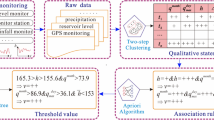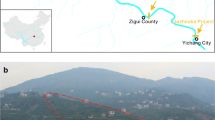Abstract
Several extensive landslides have occurred in the vicinity of the Three Gorges Reservoir since its initial impoundment in June 2003. A reduction of the landslide risk is essential for the safety and security of lives and property in the region. This study analyses the deformation states of two typical colluvial landslides (the Baijiabao and Laoshewo landslides) using 6 years of monitoring data, a two-step cluster analysis, and the Apriori algorithm. The landslide displacement versus time curves exhibit step-like patterns, and the landslide deformation is highly correlated with fluctuations in the reservoir level and seasonal precipitation. To determine different types of landslide deformation, the monthly displacement curves of the colluvial landslides are classified into three types using a two-step cluster analysis: initial deformation, constant deformation, and rapid deformation. Five driving factors were selected as the antecedents for the Apriori algorithm to obtain rules that describe the relationships between the landslide deformation and the influential parameters. These factors include the cumulative precipitation over the previous month, the maximum daily precipitation during the current month, changes in the reservoir level over the previous month, cumulative increases in the reservoir level and the average reservoir level during the current month. The analytical results were validated by comparing them with observed landslide deformation characteristics using three measurement standards: support, confidence and lift. The results show that the combined method of a two-step cluster analysis with the Apriori algorithm can effectively model the landslide deformation states that are associated with the Baijiabao and Laoshewo landslides. Moreover, this method may serve as a potential reference for deformation analyses of colluvial landslides in the Three Gorges.















Similar content being viewed by others
References
Agrawal R, Srikant R (1994) Fast algorithms for mining association rules. In: Proceedings of the 20th international conference on very large data bases, VLDB, vol 1215, pp 487–499
Babic V, Vancetovic J, Prodanovic S, Andjelkovic V, Babic M, Kravic N (2012) The identification of drought tolerant maize accessions by two-step cluster analysis. Rom Agric Res 29:53–61
Chen H, Zeng Z (2013) Deformation prediction of landslide based on improved back-propagation neural network. Cogn Comput 5(1):55–62
Chiu T, Fang D, Chen J, Wang Y, Jeris C (2001) A robust and scalable clustering algorithm for mixed type attributes in large database environment. In: Proceedings of the seventh ACM SIGKDD international conference on knowledge discovery and data mining. ACM, New York, pp 263–268
Du J, Yin K, Lacasse S (2013) Displacement prediction in colluvial landslides, Three Gorges Reservoir, China. Landslides 10:203–218
Fourniadis IG, Liu JG, Mason P (2007) Landslide hazard assessment in the Three Gorges area, China, using ASTER imagery: Wushan-Badong. Geomorphology 84:126–144
Guo Z, Chi D, Wu J, Zhang W (2014) A new wind speed forecasting strategy based on the chaotic time series modelling technique and the Apriori algorithm. Energ Convers Manage 84:140–151
He K, Li X, Yan X, Guo D (2008) The landslides in the Three Gorges Reservoir Region, China and the effects of water storage and rain on their stability. Eng Geol 55(1):55–63
Helmstetter A, Sornette D, Grasso JR, Andersen JV, Gluzman S, Pisarenko V (2004) Slider block friction model for landslides: application to Vaiont and La Clapière landslides. J Geophys Res 109(B02409):1–15
Huang B, Yin Y, Wang S, Chen X, Liu G, Jiang Z, Liu J (2014) A physical similarity model of an impulsive wave generated by Gongjiafang landslide in Three Gorges Reservoir, China. Landslides 11:513–525
Jian W, Xu Q, Yang H, Wang F (2014) Mechanism and failure process of Qianjiangping landslide in the Three Gorges Reservoir, China. Environ Earth Sci 72:2999–3013
Jiao YY, Song L, Tang HM, Li YA (2014) Material weakening of slip zone soils induced by water level fluctuation in the ancient landslides of Three Gorges Reservoir. Adv Mater Sci Eng 2014. doi:10.1155/2014/202340
Li X, Kong J (2014) Application of GA-SVM method with parameter optimization for landslide development prediction. Nat Hazards Earth Syst Sci 14(3):525–533
Li X, Kong J, Wang Z (2012) Landslide displacement prediction based on combining method with optimal weight. Nat Hazards 61(2):635–646
Lian C, Zeng Z, Yao W, Tang H (2014) Ensemble of extreme learning machine for landslide displacement prediction based on time series analysis. Neural Comput Appl 24(1):99–107
Liu JP, Zeng ZP, Liu HQ, Wang HB (2011) A rough set approach to analyze factors affecting landslide incidence. Comput Geosci 37:1311–1317
Liu Z, Xu W, Shao J (2012) Gauss process based approach for application on landslide displacement analysis and prediction. CMES-Comp Model Eng 84(2):99–122
Liu Z, Shao J, Xu W, Chen H, Shi C (2014) Comparison on landslide nonlinear displacement analysis and prediction with computational intelligence approaches. Landslides 11(5):889–896
Lv Y, Liu H (2012) Prediction of landslide displacement using grey and artificial neural network theories. Adv Sci Lett 11(1):511–514
Martínez IN, Morán JM, Peña FJ (2006) Two-step cluster procedure after principal component analysis identifies sperm subpopulations in canine ejaculates and its relation to cryoresistance. J Androl 27(4):596–603
Matías JM, Taboada J, Ordóñez C, González-Manteiga W (2010) Partially linear support vector machines applied to the prediction of mine slope movements. Math Comput Model 51(3–4):206–215
Miao H, Wang G, Yin K, Kamai T, Li Y (2014) Mechanism of the slow-moving landslides in Jurassic red-strata in the Three Gorges Reservoir, China. Eng Geol 171:59–69
Mufundirwa A, Fujii Y, Kodama J (2010) A new practical method for prediction of geomechanical failure time. Int J Rock Mech Min Sci 47(7):1079–1090
Niu R, Wu X, Yao D, Peng L, Ai L, Peng J (2014) Susceptibility assessment of landslides triggered by the Lushan Earthquake, April 20, 2013, China. IEEE J-Stars 7(9):3979–3992
Pradhan B (2010a) Remote sensing and GIS-based landslide hazard analysis and cross-validation using multivariate logistic regression model on three test areas in Malaysia. Adv Space Res 45(10):1244–1256
Pradhan B (2010b) Landslide susceptibility mapping of a catchment area using frequency ratio, fuzzy logic and multivariate logistic regression approaches. J Indian Soc Remote Sens 38(2):301–320
Pradhan B (2013) A comparative study on the predictive ability of the decision tree, support vector machine and neuro-fuzzy models in landslide susceptibility mapping using GIS. Comput Geosci 51:350–365
Pradhan B, Lee S (2010) Landslide susceptibility assessment and factor effect analysis: backpropagation artificial neural networks and their comparison with frequency ratio and bivariate logistic regression modelling. Environ Modell Softw 25:747–759
Pradhan B, Youssef AM, Varathrajoo R (2010) Approaches for delineating landslide hazard areas using different training sites in an advanced artificial neural network model. Geo-Spatial Inf Sci 13(2):93–102
Pradhan B, Mansor S, Pirasteh S, Buchroithner MF (2011) Landslide hazard and risk analyses at a landslide prone catchment area using statistical based geospatial model. Int J Remote Sens 32(14):4075–4087
Randall WJ (2007) Regression models for estimating coseismic landslide displacement. Eng Geol 91(2–4):209–218
Ren F, Wu X, Zhang K, Niu R (2015) Application of wavelet analysis and a particle swarm-optimized support vector machine to predict the displacement of the Shuping landslide in the Three Gorges, China. Environ Earth Sci 73(8):4791–4804
Tang JY, Chuang LY, Hsi E, Lin YD, Yang CH, Chang HW (2013) Identifying the association rules between clinicopathologic factors and higher survival performance in operation-centric oral cancer patients using the Apriori algorithm. Biomed Res Int 2013. doi:10.1155/2013/359634
Van Asch TWJ, Hendriks MR, Hessel R et al (1996) Hydrological triggering conditions of landslide in varved clays in the French Alps. Eng Geol 42:239–251
Wang F, Zhang Y, Huo Z, Peng X, Araiba K, Wang G (2008) Movement of the Shuping landslide in the first four years after the initial impoundment of the Three Gorges Dam Reservoir, China. Landslides 5(3):321–329
Wang J, Xiang W, Lu N (2014) Landsliding triggered by reservoir operation: a general conceptual model with a case study at Three Gorges Reservoir. Acta Geotech 9:771–788
Wu X, Niu R, Ren F, Peng L (2013) Landslide susceptibility mapping using rough sets and back-propagation neural networks in the Three Gorges, China. Environ Earth Sci 70(3):1307–1318
Xia M, Ren GM, Ma XL (2013) Deformation and mechanism of landslide influenced by the effects of reservoir water and rainfall, Three Gorges, China. Nat Hazards 68:467–482
Yin Y, Wang H, Gao Y, Li X (2010) Real-time monitoring and early warning of landslides at relocated Wushan Town, the Three Gorges Reservoir, China. Landslides 7(3):339–349
Zhang JF, Li ZG, Qi T (2005) Mechanism analysis of landslide of a layered slope induced by drawdown of water level. Sci China Ser E Eng Mater Sci 48(S):136–145
Zhou CH, Lee CF, Li J, Xu ZW (2002) On the spatial relationship between landslides and causative factors on Lantau Island, Hong Kong. Geomorphology 43(3):197–207
Zhu C, Hu G (2013) Time series prediction of landslide displacement using SVM model: application to Baishuihe landslide in Three Gorges reservoir area, China. Appl Mech Mater 239–240:1413–1420
Acknowledgments
We would like to thank Dr. LaMoreaux and the anonymous reviewers for their valuable comments. This study was jointly supported by the National Natural Science Foundation of China (41501470), the Open Fund of the Key Laboratory of Urban Land Resources Monitoring and Simulation, the Ministry of Land and Resources (KF-2015-01-006), the Open Fund of Hubei Province Key Laboratory of Regional Development and Environmental Response (2015(B)001), and the Open Research Fund Program of Shenzhen Key Laboratory of Spatial Smart Sensing and Services (Shenzhen University). The authors would also like to thank the members of the Administration of Prevention and Control of Geo-Hazards in the Three Gorges Reservoir of China for their assistance during the data collection.
Author information
Authors and Affiliations
Corresponding author
Rights and permissions
About this article
Cite this article
Wu, X., Benjamin Zhan, F., Zhang, K. et al. Application of a two-step cluster analysis and the Apriori algorithm to classify the deformation states of two typical colluvial landslides in the Three Gorges, China. Environ Earth Sci 75, 146 (2016). https://doi.org/10.1007/s12665-015-5022-2
Received:
Accepted:
Published:
DOI: https://doi.org/10.1007/s12665-015-5022-2




